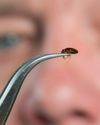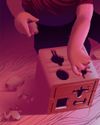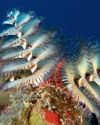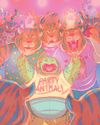
BEAUTIFUL BUT DEADLY
Famous for being some of the world's deadliest animals, blue-ringed octopuses are usually quite docile and spend most of their time hiding in rubble and shells. There are between four and 10 species in the Hapalochlaena genus, living in shallow seas from Australia to Japan. They are all less than a handspan in size, and each has around 60 bright blue rings which flash as a warning when the octopus feels threatened. The rings contain multilayer reflectors, arranged to reflect blue-green light. The flashing is controlled by muscles that pinch in a surrounding layer of black-pigmented chromatophore cells that cover the blue iridescence. When the muscles relax, the blue iridescence is exposed. The warning flashes come before the octopus deploys its deadly defensive bite. Bacteria living in their salivary glands make tetrodotoxin (TTX), the same toxin that makes pufferfish deadly to eat. Female blue-ringed octopuses cover their eggs in TTX to protect them from getting eaten.
SPECTACULARLY SEE-THROUGH
Diese Geschichte stammt aus der March/April 2022-Ausgabe von Very Interesting.
Starten Sie Ihre 7-tägige kostenlose Testversion von Magzter GOLD, um auf Tausende kuratierte Premium-Storys sowie über 8.000 Zeitschriften und Zeitungen zuzugreifen.
Bereits Abonnent ? Anmelden
Diese Geschichte stammt aus der March/April 2022-Ausgabe von Very Interesting.
Starten Sie Ihre 7-tägige kostenlose Testversion von Magzter GOLD, um auf Tausende kuratierte Premium-Storys sowie über 8.000 Zeitschriften und Zeitungen zuzugreifen.
Bereits Abonnent? Anmelden

TAKE IT SLOW
Slow running is a fitness trend with some hard and fast science behind it

Physics, AI and music share a common thread. You just have to know where to look
Studying science can lead you in many directions and open doors to unexpected possibilities along the way

BED BUGS VS THE WORLD
When bloodthirsty bed bugs made headlines for infesting Paris Fashion Week in 2023, it shone a spotlight on a problem that's been making experts itch for decades: the arms race going on between bed bugs and humans

Kids are the key to understanding obesity. But we need more of their genes...
We can unravel the role that bodyweight plays in disease, but we need a bigger, more diverse, sample of genetic material to do so

COVID inquiry: What did we learn and what can we do better in future pandemics?
Masks, social distancing, lockdowns... how effective was the UK's response to the COVID-19 pandemic?

One hormone could be the key that unlocks a cure for morning sickness
The nausea and vomiting that, in extreme cases, can endanger mothers and babies might soon be just a memory

THE WORLD'S WEIRDEST CREATURES
Under the sea and upon the land, some animals look - to us - pretty strange...

WHEN MIND AND MACHINE COLLIDE
First, Elon Musk wanted to make electric cars ubiquitous, then he wanted to make space exploration a private enterprise. Now, with Neuralink, his newest venture, Musk hopes to merge humans and artificial intelligence. Turns out, it might not be such a crazy idea...

COME OUT OF YOUR SHELL
Social anxiety is more than just being shy. It's a phobia born out of our evolutionary past. But that raises a puzzling question: why do so many of us fear human interaction when we're supposed to be the most sociable species on the planet?

SPACE ODDITIES
Take a tour of the weirdest spots in the universe, where the 'normal' rules don't apply. Places that squeeze time, blow bubbles and even rain glass... sideways